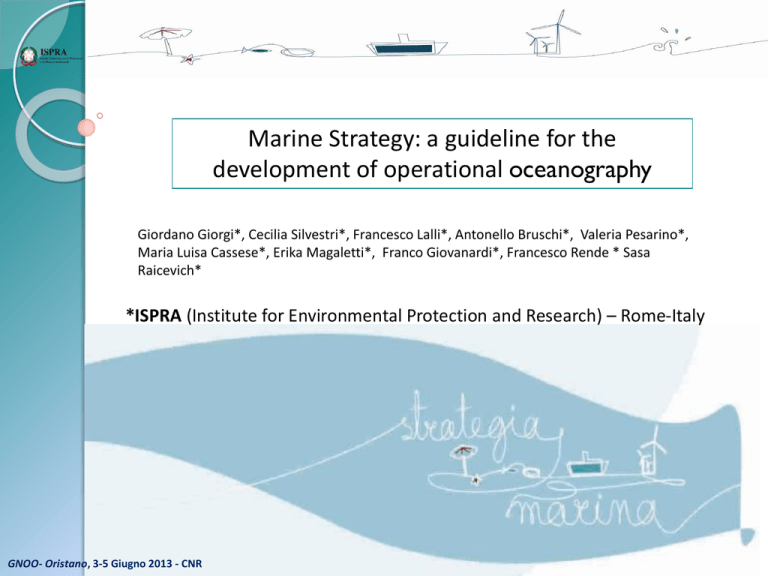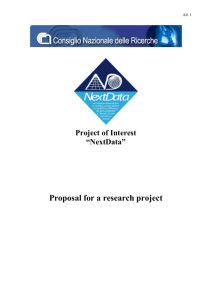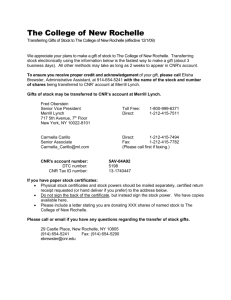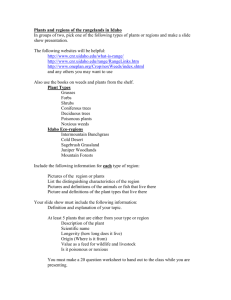a guideline for the development of operational
advertisement

Marine Strategy: a guideline for the development of operational oceanography Giordano Giorgi*, Cecilia Silvestri*, Francesco Lalli*, Antonello Bruschi*, Valeria Pesarino*, Maria Luisa Cassese*, Erika Magaletti*, Franco Giovanardi*, Francesco Rende * Sasa Raicevich* *ISPRA (Institute for Environmental Protection and Research) – Rome-Italy GNOO- Oristano, 3-5 Giugno 2013 - CNR On July 15, 2008 came into force the Marine Strategy Framework Directive (Directive 2008/56/EC) The main objective: to achieve or maintain good environmental status in the marine environment by the year 2020. Good environmental status: the environmental status of marine waters, considering the structure, functions and processes of the constituent marine ecosystems together with the associated physiographic, geographic and climatic factors, hydromorphological, physical and chemical properties, including those resulting from human activities in the area concerned. The use of the marine environment is at level that is sustainable. GNOO- Oristano, 3-5 Giugno 2013 - CNR Spatial scale of the Directive WFD GNOO- Oristano, 3-5 Giugno 2013 - CNR MSFD Steps for National Marine Strategies development 2012 Building upon existing activities developed within EU Directives and Regional Sea Conventions 2020 To achieve or maintain Good Environmental Status in the marine environment Adaptive management , with regular review (every 6 years) GNOO- Oristano, 3-5 Giugno 2013 - CNR The initial assessment of marine waters through the existing data Data currently available GNOO- Oristano, 3-5 Giugno 2013 - CNR RS- Physical features Parameters Data/information used Topography Bathymetry Surveys Sea Surface Temperature Satellite data SeaBottom Temperature Turbidity Oceanographic campaigns MyOcean’s numerical model Oceanographic campaigns Upwelling Mixing characteristics RMN and satellite data MyOcean’s numerical model Salinity MyOcean’s numerical model Current velocity MyOcean’s numerical model Wave Exposure ECMWF numerical model ResidenceTime MyOcean’s data post processing lagrangian particle model GNOO- Oristano, 3-5 Giugno 2013 - CNR RS- Interference with hydrological process Report WISE RBMP data on analysis of pressures and impacts of coastal water bodies due to saline and temperature changing regime RS- Nutrient and organic matter enrichment RS- Descriptor 5: Eutrophication Parameters Data/information used Nutrients In situ monitoring data MyOcean’ s numerical model LTER-MC database VECTOR-NASA database Oxygen In situ monitoring data Chlorophyll a In situ monitoring data Satellite data phytoplankton In situ monitoring data GNOO- Oristano, 3-5 Giugno 2013 - CNR Determination of Good Environmental Status GES D1-Biodiversity 14 Indicators D2-Non idegenous species 3 Indicators D3-Fisheries 7 Indicators D4-Food web 3 Indicators D5-Eutrophication D6-Seafloor integrity 8 Indicators 6 Indicators D7-Hydrgrafic condition 3 Indicators D8-Contaminants 3 Indicators D9-Contaminants in seafood 2 Indicators D10-Litter 4 Indicators D11-Noise 2 Indicators GNOO- Oristano, 3-5 Giugno 2013 - CNR 56 Art 8a: Characteristics Art 8b: Pressures & impacts Art. 9 GES C1: Physical features C2: Chemical features C3: Habitats C4: Functional groups C5: Species C6: Ecosystems C7: Other features P1: Physical loss P2: Physical damage P3: Underwater noise P4: Marine litter P5: Hydrology P6: Contaminants P7: Nutrient and organic matter enrichment P8: Microbial pathogens P9: Non-indigenous spp P10: Selective extraction D1 Biodiversity D2 Non-Indigenous species D3 Fisheries D4 Food webs D5 Eutrophication D6 Seafloor integrity D7 Hydrographic conditions D8 Contaminants D9 Contaminants in seafood D10 Litter D11 Underwater noise GNOO- Oristano, 3-5 Giugno 2013 - CNR Report MSFD Initial assessment Italy Paper report General context, methodologies, Executive summary Determination of GES Establishment of environmental target Reporting sheets Analytical information (data) October 2012 Supporting documents Cartography, detailed information, bibliography etc. April 2013 QA/QC European Environmental Agency REPORTNET WISE Marine GNOO- Oristano, 3-5 Giugno 2013 - CNR European Commission La Direttiva Quadro sulla Strategia per l’Ambi TIMING 2012 According to the MSFD management cycle, at the moment all Member Initial assessemnt, determination of States completed both the Initial and the Determination of GES, assessment establishment of target their GES . G 2013 F M A M G L A S O N D Now the EC is assessing all reports and already 1°a Reporting high variability of to EC 2° Reporting to EC approaches is resulted. G F M A M G L A S O N D The lack of specific methodologies and/or technical guidelines regarding some descriptors and related indicators limits an EU-wide harmonisation Monitoring programmes 2014 G F M A M G L A S N D Elaboration of programmes of measures 2015 G F M A M G L A S O N D Start up of Programmes of measures 2016 G GNOO- Oristano, 3-5 Giugno 2013 - CNR O F M A M G L A S O N D Which scientific gaps have been highlighted by the initial assessment? Identification of geographical and functional limits (range of variability) of ecosystems Assessment of the cumulative impacts of human pressures on benthic, pelagic habitat integrity as well as ecosystem functioning and their effects on biodiversity Impacts on benthic and pelagic communities due to alteration of hydrological characteristics Physiographic features and consequences for food-web structure and functional ecosystem processes GNOO- Oristano, 3-5 Giugno 2013 - CNR MSFD – Ecosystem approach and Adaptive management with regular review (every 6 years) The ecosystem approach requires adaptive management to deal with the complex and dynamic nature of ecosystems and the absence of complete knowledge or understanding of their functioning…. Management must be adaptive in order to be able to respond to such uncertinties and contain elements of “learning-by-doing” or research feedback. Measures may need to be taken even when some cause-and-effect relationships are not yet fully established scientifically GNOO- Oristano, 3-5 Giugno 2013 - CNR 2012 Determination of Good Environmental Status (Art. 9) 2012 Establishment of environmental targets and associated indicators (Art. 10) 2014 Establishment and implementation of coordinated monitoring programmes (Art. 11) First Cycle 2012 Initial assessment (Art. 8) 2015 Development of programmes of measures (Art. 13) Some gaps could be compensed during the following MSFD cycle (ending in 2018) by developing new methods and gathering additional data 2016 Entry into operation of the programmes of measures ( Art. 13) Review of Good Environmental Status (Art. 9) Assessment (Art. 8) Modification of the programmes of measures ( Art. 13) GNOO- Oristano, 3-5 Giugno 2013 - CNR Following Cycles Review of environmental targets (Art. 10) Continuation of monitoring programmes (Art.11) Review of programmes of measures (Art. 13) Is t possible to reduce these scientific gaps? YES………advancing a methodological framework in order to provide guidelines for developing operational oceanography GNOO- Oristano, 3-5 Giugno 2013 - CNR HOW? 1) Defining the geographical and functional limits (range of variability) of ecosystems using oceanographic data from models, and other more variables GNOO- Oristano, 3-5 Giugno 2013 - CNR and 2. Setting up a modelling framework for assessing the relationships between natural (such as meterological, hydrodynamical, morphological ) and human pressures (mainly eutrophication, pollution, dredging, trawiling) and the benthic and pelagic physical and ecological characteristics GNOO- Oristano, 3-5 Giugno 2013 - CNR Main step to do that…………? Characterise forcing processes Describing the generic and specific hydrological, sedimentary and biological forcing processes involved in selected areas for the pelagic and benthic environment, how human pressures affect such processes and formalising these relationships (knowledge rules) in a generic framework for modelling GNOO- Oristano, 3-5 Giugno 2013 - CNR Set up a modelling framework Select the available models for simulating the state and dynamics of the benthic and pelagic, physical and ecological processes and how natural and antropogenic pressures in general relate to the various parameters and modules in the model. Developing sets of submodels to be intercompared: physical forcing models, biogeochemical models, and ecological models Set up an end-to-end modelling framework, integrating above mentioned modules. GNOO- Oristano, 3-5 Giugno 2013 - CNR Pelagic model Pelagic ecology must be described by grouping higher trophic level organism in functional groups, or focusing on target species, by following carbon dynamics and energy flows and by deriving synthetic indicators of ecosystem structure and functioning GNOO- Oristano, 3-5 Giugno 2013 - CNR Benthic model Benthic ecology must be simulated up to species functional groups distributions, tolerant/sensitivespecies groups, etc..) habitat (gamma diversity, i.e assemblages in landscapes, small scale morphological features), and ecosystem fubctionality (functional carbon processsing, relationships with demersal fish production GNOO- Oristano, 3-5 Giugno 2013 - CNR (diversity, size heterogeneity to mesoscale traits, organic End-to-End model Integration a coupled benthic pelagic biogeochimical model and a marine food web model GNOO- Oristano, 3-5 Giugno 2013 - CNR Testing and validation of indicators for: D1 (Biodiversity) D4 (Food webs) D5 (Eutrophication) D6 (Seafloor integrity) D7 (Hydrological alteration) Selecting indicators for the three levels (species, habitat and ecosystem functioning) among those chosen in the determination of GES and formalising them within the three modules: •Dose-effect relationships for each pressure and indicator combination •Calibration runs for reliability and sensitivity analyses to test indicator performance •Indicator validation in the subregional multiple/cumulative pressures GNOO- Oristano, 3-5 Giugno 2013 - CNR seas for How to reduce the gap about the impacts on benthic and pelagic communities due to alteration of hydrological characteristics? 1) Description of the quantitative level of pressure due to change of the thermal regime or salinity using parameters: volume, flow, dispersion. The tools for this study are models of hydrodynamics and coastal oceanography (MyOcean) and monitoring. 2) Description of the quantitative level of impact due to changes in the thermal regime and salinity through the study of the alteration of community (eg species composition) and ecosystem functions. Possible tools: modeling, mapping of benthic habitats (EuSeaMap) and monitoring. GNOO- Oristano, 3-5 Giugno 2013 - CNR Development of innovative monitoring systems Integrating the information from tested and validated indicators and developed modelling tools to develop innovative monitoring approach, that efficiently and effectively assess the effects of human activities on marine environment in space and time, providing data/advices useful to achieve or maintain “good environmental status”. These monitoring systems could support ongoing monitoring programs of Member States that shall be implemented by 2014 according to Article 5 and 11 of MSFD. GNOO- Oristano, 3-5 Giugno 2013 - CNR GNOO- Oristano, 3-5 Giugno 2013 - CNR



